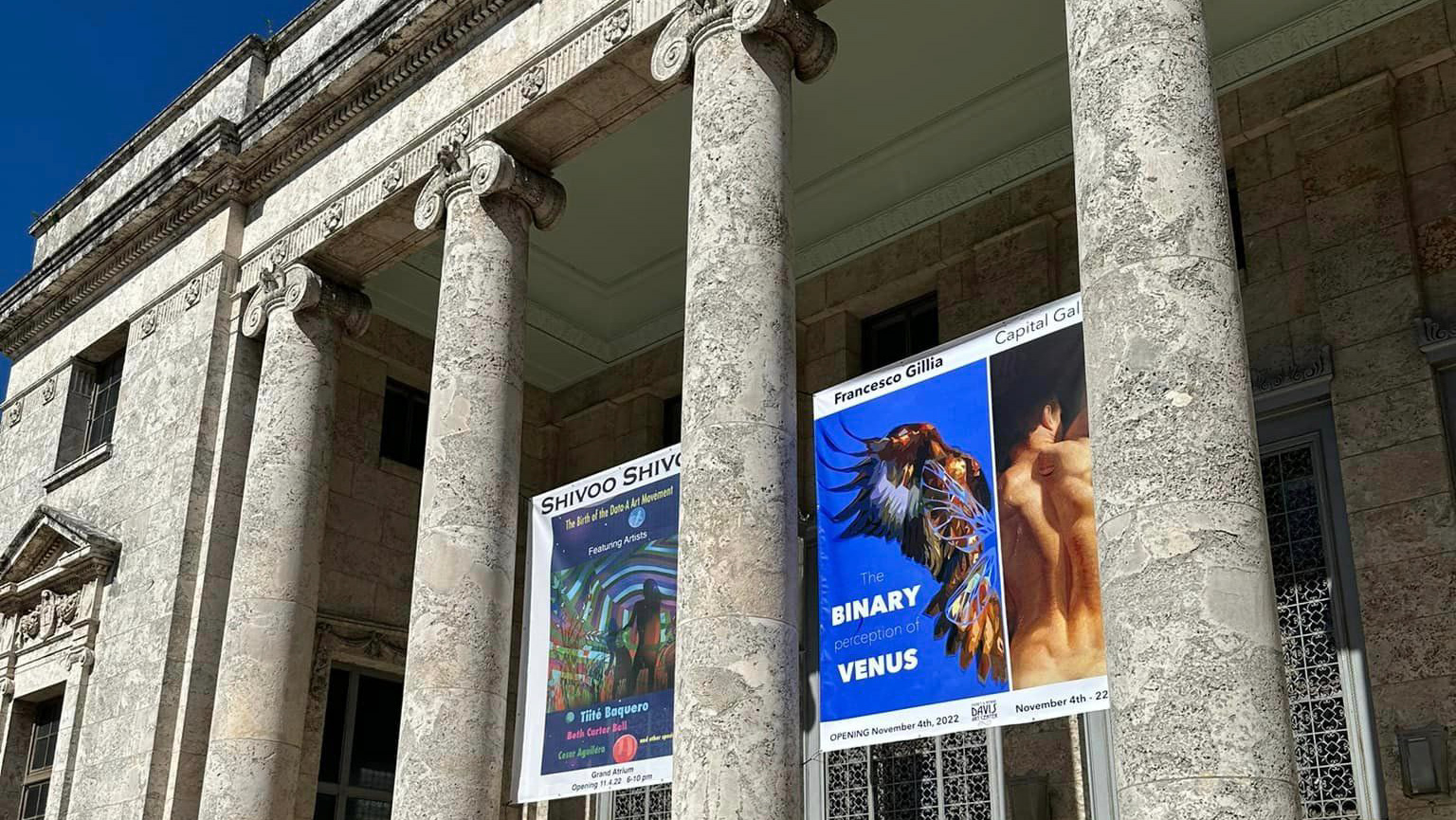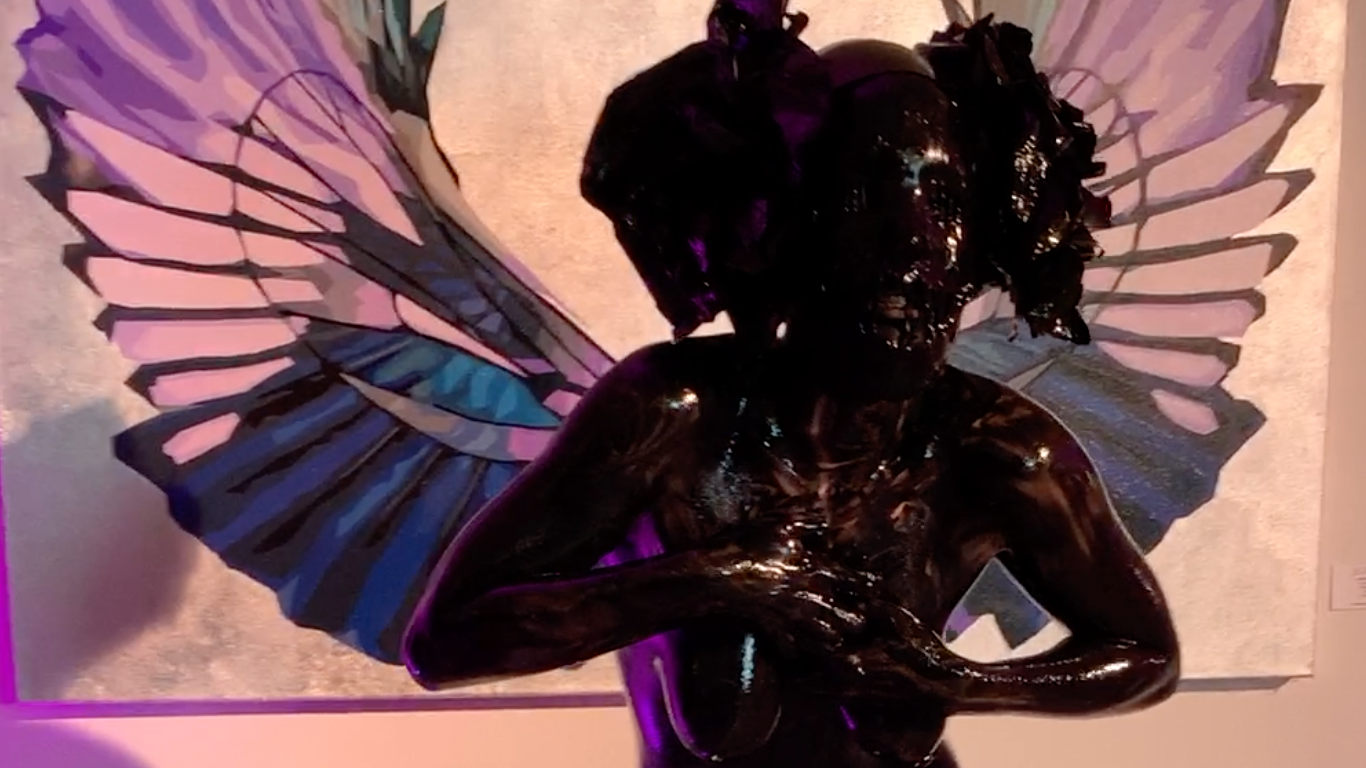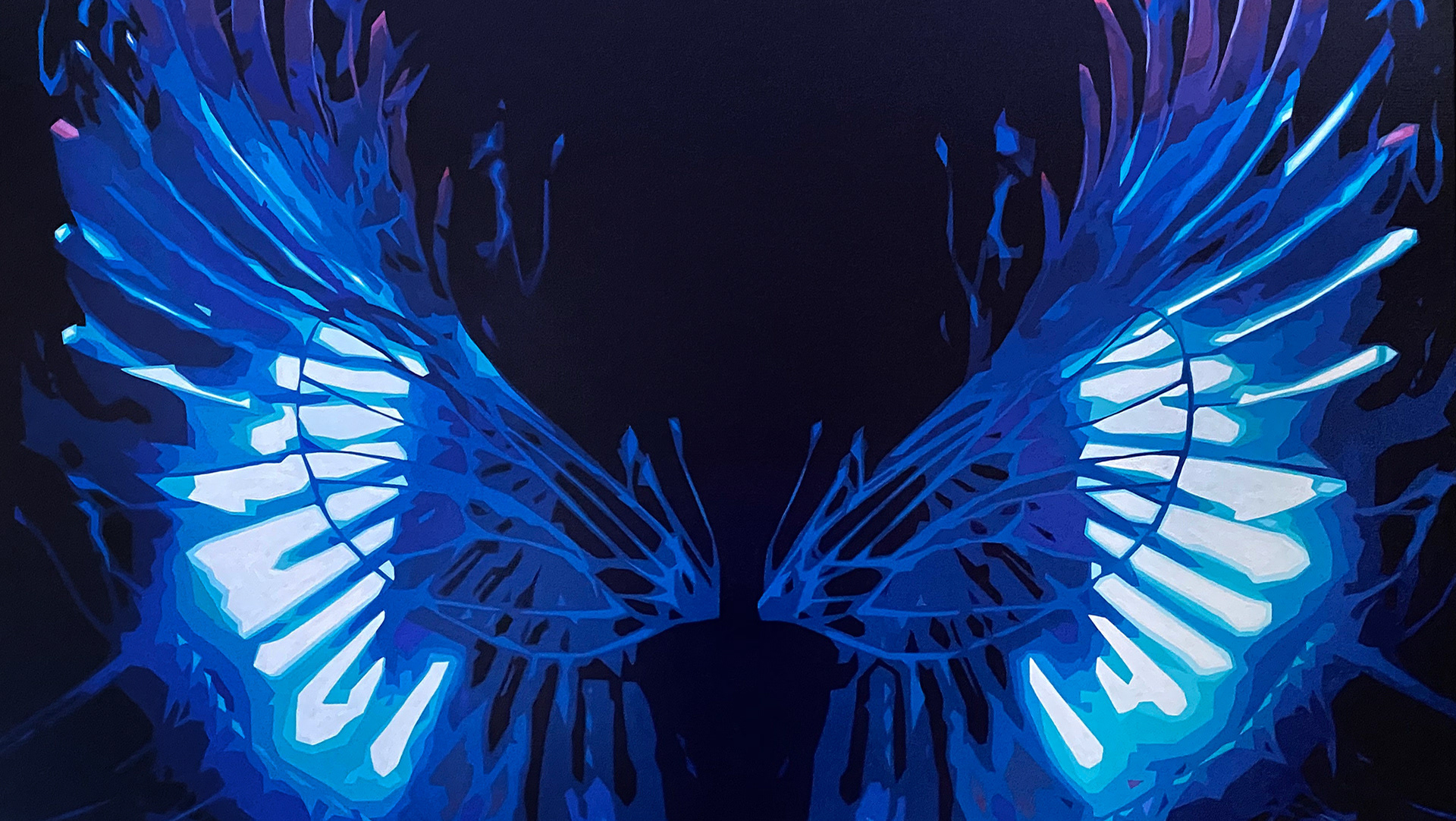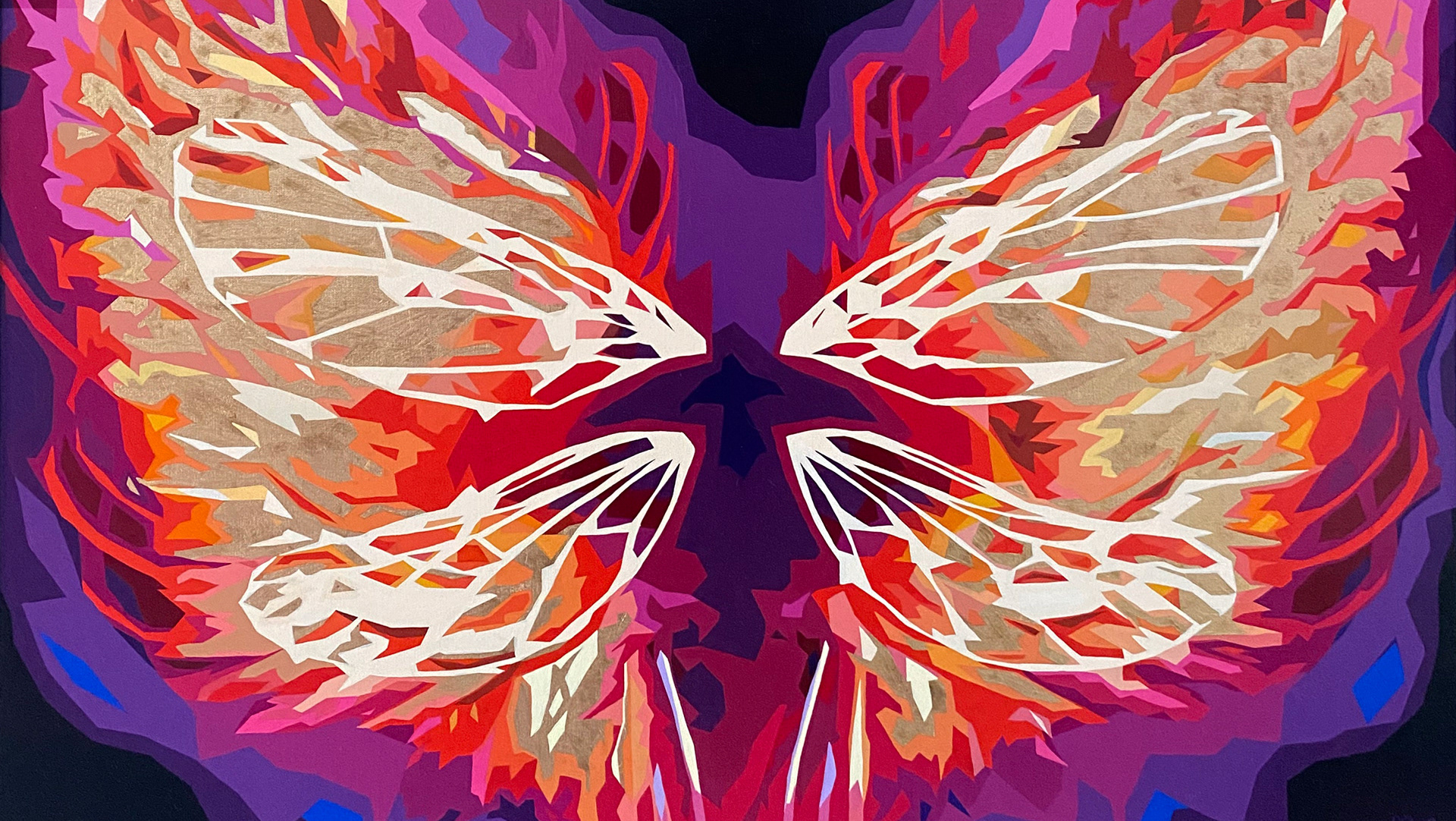Echo's Dream
This installation is an attempt to comment on the state of art in relation to the human outlook in the modern era. While an ambitious goal, the means by which art can influence people lies in the boundaries of abstracts, allusions, and the personal bond that forms between person and portrait, something an experienced artist is capable of managing. It is for this reason that the Echo’s Dream installation was devised.
Echo’s Dream is a series that, through inverting the premise of Francesco’s earlier work Pronaos, seeks to critique the capitalist view of art and the views of the audience themselves. The geometric designs and vibrant colors act to lull viewers into the façade that they are just modern paintings, like the adverts, book covers or app imagery so ubiquitous in the technologically inclined United States. Instead of wings bound to age, shadow or texture, each of the 6 paintings are amalgamations of real items, distortions that reflect reality in a silver background. Negative space between the colors invite viewers to stand between them, taking photos that make them appear as angels, giving them the illusion that they have wings, their diversity meant to appeal to multiple aspects of the public. The title Echo’s Dream is in reference to a specific Greek myth, the tale of Narcissus. To summarize, a boy is born to a union between a river god and a woman of great affluence, with this demigod status for their child, they decide to consult an oracle for guidance on how to raise him. Liriope, the mother, asks the man if her boy will live to see a good old age, and the seer responds “Yes, if he never knows himself.” (Ovid) Growing up into a handsome lad, the man named Narcissus still is unable to find love, not due to a lack of people who are infatuated with him, but simply his own feelings. Upon finding himself lost in the woods, Narcissus begins being followed by a nymph, a forest spirit who has fallen in love with him.
This nymph is Echo, a woman cursed by the gods to be a mute, only able to communicate with others by uttering the last words they said to her. When she attempts to profess her love to the man, he refuses her and continues on his way, her sadness immeasurable. She was not the only nymph that had been rejected by Narcissus, in fact, a male from before decides to end his life with love unrequited, but before he can do so he calls out for someone to give Narcissus a love that is unobtainable. The goddess Nemesis listens, and so puts a great pond within the woods. Here Narcissus stops, seeing his reflection in the water he becomes entranced, his attempts to reach out and kiss himself are but in vain, as the water ripples and ruins his reflection. He has found love and found himself, but it can never be realized. And so, Echo gazes on as Narcissus spends his life looking into the water, his admiration for his reflection withering him away each day. Eventually, he loses himself, a bright flower with white petals and a yellow trumpet erupting from his death spot, and Echo sits away for eternity for the boy who lost himself in his own admiration. (Writer, n.d.)
This nymph is Echo, a woman cursed by the gods to be a mute, only able to communicate with others by uttering the last words they said to her. When she attempts to profess her love to the man, he refuses her and continues on his way, her sadness immeasurable. She was not the only nymph that had been rejected by Narcissus, in fact, a male from before decides to end his life with love unrequited, but before he can do so he calls out for someone to give Narcissus a love that is unobtainable. The goddess Nemesis listens, and so puts a great pond within the woods. Here Narcissus stops, seeing his reflection in the water he becomes entranced, his attempts to reach out and kiss himself are but in vain, as the water ripples and ruins his reflection. He has found love and found himself, but it can never be realized. And so, Echo gazes on as Narcissus spends his life looking into the water, his admiration for his reflection withering him away each day. Eventually, he loses himself, a bright flower with white petals and a yellow trumpet erupting from his death spot, and Echo sits away for eternity for the boy who lost himself in his own admiration. (Writer, n.d.)
Around 10 years ago, Francesco Gillia displayed his installation known as Pronaos, large columnized portraits of nude human forms laid bare, visages of stark human anatomy. The idea behind Pronaos lay within in its namesake, referring to the area that lies right before the main cavern of a church. The pronaos in the Pantheon, for example, is enclosed by massive grey columns which support the structure’s triangular face and allow passage between the outside world and the sacred inner sanctum. (Blankenbehler, n.d.) Arising from the Roman approach towards religion and its pantheon of gods, Pronaos acted as both an indicator of the sacred and a boundary between the religious and material domains.
Humans have a sociological aversion to nudity in everyday life, something exacerbated by the deliberate restriction of sexual imagery in film and advertisement to make a profit on pornography and its ilk. (Voto, n.d.) Francesco sought to grant the viewer the perspective of a child unafflicted by the social ethos in his framing of the paintings, like a toddler who looks upon their parents and sees giants; the paintings were designed to be 6-8 feet in height in order to make the viewer feel as if they are a small child. By focusing on the torso and abdomen, the paintings became more akin to structures, their legs supporting the absent face and allowing the audience to imprint their own parental image on it; their own perception of parenthood adding a layer of connection between the two. In keeping the realism of the skin, folds and imperfections, the paintings can also be seen as mirrors of their subjects and testaments to the acceptance of our bodily differences. Because it was fairly successful, Francesco decided to continue to add upon the themes of his work, instead of taking the superficially profane and making it sacred, it would follow that he would take a sacred image and
bastardize it. Birds, and more specifically their means of ascension, are used in art and religion as extensions of the divine, angels are the messengers of God in Abrahamic religions, Garuda is the mount of Vishnu in the Hindu religion and the hawk form of Horus serves as an upper god in Egyptian mythology (Cartwright, n.d.). Wings represent freedom for many, allowing animals to leave the embrace of gravity and escape to the heavens.
So what better image to render profane than a symbol of divinity itself?
The tragedy of Ovid’s Narcissus lies not just in the young man’s demise, but in the countless people who were left behind heartbroken, and within the melancholy of the nymph Echo. Self-infatuation can lead a person towards destruction, be it the photos that are plastered of oneself on the internet, the portraits of others or the picture we take with a painting. Narcissus serves as a reminder that some people will always be doomed by their own shortcomings, but Echo herself represents the idea that others can be taken down with them. Echo herself wished for an ideal situation where her love would have been fulfilled, her feelings acknowledged, and her presence accompanied by another. Humans have a need for other people, not just for love, but for support and help, and because we feel these desires to need others and to appreciate ourselves, we can sympathize with both Narcissus and Echo, their names and story remaining germane across millennia.
So, how does this relate to the wings? Because the symbol of higher power is captured in a deceptive display, it becomes the pond which Narcissus looks at himself within. While the ethereal beauty that Ovid conveys cannot yet be captured in a still reflection, the photos that people will take with the wings will serve the function of making them appear more vibrant. But, while they can pose and appreciate the photo all they want, they can only find a requited sense of completion if they find others to bond with, be it the one who takes their photo, or an Echo who looms near them. The dream of this other will be fulfilled only when the viewer looks past the ornaments and plumage of the paintings and sublimates the dream of their Echo. The paintings are an attempt to get people to think beyond the superficial nature of art, and to understand that it is, ultimately a means to invoke ideas in people, to inspire or captivate them, and that the open maw of the venus flytrap is only colored red in order to entrap them in a cycle of distraction. Instead of conforming the human body to the sacred, the idea of the sacred becomes confined to the human form, stuck jetting out of their backs while they immortalize it within a mirror. The images that have stuck in the minds of humankind since they began to imprint on the earth are corrupted, made to resemble kaleidoscopic colorations entrapped in a false gold and silver lining, becoming false idols which draw in the audience like a spiral. Yet, as the final words that Echo whispers before being lost to time, the title and the need for another will triumph over the inverted wings, and people can leave the building considering the myth of Narcissus, the warning of what art as deception can be and how it will try to reach them. Hopefully, by the end of their stay, they can reminisce on Echo’s Dream, and whisper farewell as they gaze upon the ensnaring imitations of life and overcome them.
Works Cited
Blankenbehler, B. (n.d.). The Pantheon: Rome's Architecture of the Cosmos. Retrieved from
Blankenbehler, B. (n.d.). The Pantheon: Rome's Architecture of the Cosmos. Retrieved from
http://www.architecturerevived.com/the-pantheon-romes-architecture-of-the-cosmos/
Cartwright, M. (n.d.). Garuda. Retrieved from https://www.ancient.eu/Garuda/
Ovid. (n.d.). Metamorphosis III.
Voto, J. (n.d.). Why is America so Afraid of Sex and Nudity? Retrieved from https://www.theodysseyonline.com/america-scared-sex-nudity
Writer, U. (n.d.). Retrieved from The Myth of Narcissus as in the Metamorphosis of Ovid: https://classicalartsuniverse.com/myth-of-narcissus-in-metamorphoses-of-ovid/
Glen Romano Gillia





